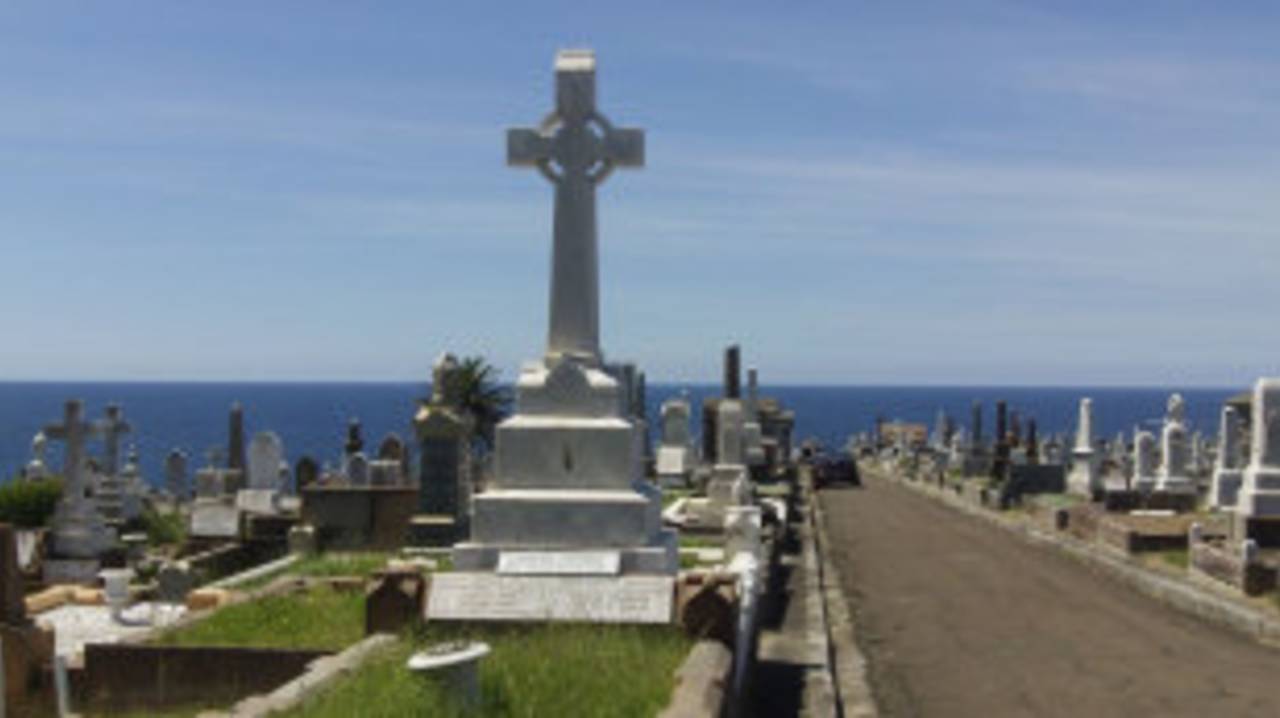Rest In Peace. That's what we say when people die. It is a wish usually meant for the soul, and whether a soul exists or not is beyond this space to discuss. When it comes to dead bodies, though, you will have done really well to find a more picturesque or peaceful resting place than the Waverley Cemetery in the Bronte suburb in Sydney.
On a clear day like today, in the background of the white marble of tombstones, two stunning hues of azure meet each other, the lighter one of the sky, and the darker one of the Pacific Ocean. The slope of the hill on which the graveyard is built adds to the beauty of it all. What brings me here is no morbid fascination with death or the dead, but a visit - on a slow day - to the grave of the great
Victor Trumper, who died of Bright's disease at the age of 37.
There are various kinds of graves. Some grand ones, some poorly kept. Some tombstones have depictions of an angel, some of father time, some a mere cross. Trumper's, the third-most enquired-about grave at Waverley, after Henry Lawson and the Irish Monument, is as modest as we have read him to be, devoid of any pretence. It does have a small error, though, in that it says he died aged 36.
On staying longer at the cemetery, mainly because of the peaceful surroundings and the lazy afternoon hour, this brief visit turned into a bit of a discovery. Who's Who - Sporting Lives, an excellently researched publication of the Waverley Cemetery that can be found in the office, claims there are enough cricketers buried there to form "their own graveyard XI". What a concept, even for those who don't believe in life after death but love the game.
The tar road at the corner of which Trumper's dead body rests will soon be named Trumper Avenue. Keep walking along it, then make a right into a small street, and near the end of it is buried the legendary opener, and cricket-writer,
Jack Fingleton. You'll struggle to find his grave because his plaque that reads John Henry Webb Fingleton, is hidden by the weed.
Walk back towards the Trumper Avenue, cross it, and somewhere in the middle of this block is the grave of the eccentric wicketkeeper
Hanson Carter. Carter was one of the first, if not
the first, to fully squat in his keeping stance. According to
The Encyclopaedia Of Australian Cricket , he believed doing so put less stress on the legs, and other keepers followed suit. Carter was an undertaker himself.
Australian Cricket says he often used to come straight from work to cricket, in a hearse. Carter's is an elegant grave. It is about the neatest when it comes to graves. There is a lot of space around the tombstone, which looks like a trophy. His whole family is buried here.
More difficult to find is
Henry "Monty" Faithfull. At the age of 18, Faithfull, "a deplorably good hand at pigeon-slaying", according to
The Bulletin, and his father and three brothers, were involved in a gunfight with Ben Hall's bushrangers. They were attacked when travelling to Goulburn, and retaliated with fire of their own. When they ran out of ammunition, they retreated home, and came back to fight with replenishments. Six feet tall, Faithfull troubled New South Wales' opposition with his bounce.
There are quite a few other sportspersons buried here. Apart from the other cricketers who can form an XI, there is an unusually high number of jockeys buried here, which would be only a coincidence if not for the young age of many of them. Perhaps they didn't wear helmets back then? Perhaps, like many other sports, jockeying has become safer with time?
Anyway, what of the Waverley Cemetery XI then? Trumper and Fingleton have to be the openers. Three other, lesser-acclaimed opening batsmen might have to drop down the order. Alick Bannerman was stodgy, "wearisome to the spectators", according to
Australian Dictionary of Biography. He might suit the demands of No. 3. The hard-hitting
Hugh Massie looks good for No. 4.
Charles Gregory, who fought poor health all his life but once scored 383 against Queensland, comes in at No. 5. His father,
Ned Gregory, is one of the allrounders. Arthur Callaway, a first-grade allrounder for Marrickville, happens to be at the right place and at the right time. Carter is the unanimous choice behind the stumps. Faithfull will be the experienced fast bowler, but this XI will also allow
Victor Trumper junior, just one when his father died, to play along with his old man. Trumper will share the new ball with Faithfull.
One of the two administrators - Philip Sheridan, called the father of the SCG in his Sydney Morning Herald obituary, and William Jones - will have to be the 11th player, and the other will umpire alongside the respected Richard Callaway, grandfather of allrounder Arthur Callaway. If this motley crew is not allowed entry in cricket grounds, Ned Gregory, who was also a curator at SCG, can surely help them build one of their own. If it is a field of dreams, if you build it, they will come.

